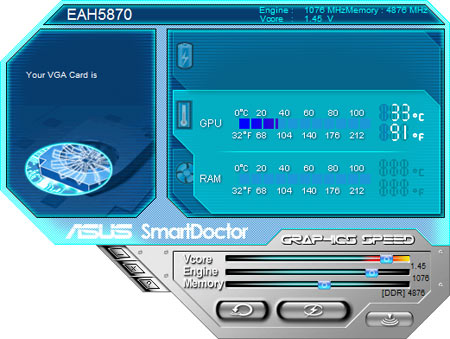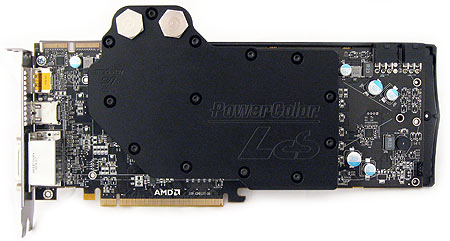PowerColor Radeon HD 5870 LCS: The GHz Limit, Broken
Conclusion
This review has given us a lot to think about and the results have surprised us quite a bit.
Radeon HD 5870 Versus 2 x Radeon HD 4890
Lets begin by considering the stock performance that the PowerColor Radeon HD 5870 LCS provides versus two Radeon HD 4890s in CrossFire. Since the PowerColor card's factory overclock was a mere 25 MHz on the core and 50 MHz for the memory, there shouldn't be a notable difference compared to the reference Radeon HD 5870 performance.
In this case, the Radeon HD 4890 CrossFire setup surprisingly achieved a handy lead over the Radeon HD 5870. This surprised us enough to give AMD a call, as we were curious why. The Radeon HD 5870 has the same number of shaders, ROPs, and texture units running at the same core clock rate as a pair of Radeon HD 4890 cards in CrossFire. The Radeon HD 5870 also sports a memory bandwidth advantage. Since CrossFire should theoretically take a scaling hit, why wasn't the single Radeon HD 5870 showing a performance win? Do the 5800-series drivers need to mature?
AMD's rep said that the explanation is likely that the Radeon HD 5870 is optimized for DirectX 11, and not DirectX 10 and 9 titles. As DirectX 11 titles are released, we'll see the 5800-series deliver even better performance.
The reasoning adds more fodder for discussion when comparing the two setups. While the Radeon HD 4890 cards delivered faster framerates, the Radeon HD 5870 also provided a smooth gaming experience at 2560x1600 with anti-aliasing applied and the highest image-quality settings selected. The only game that suffered unplayable performance on either setup was Crysis, which showed that neither solution was acceptable.
So, given the choice between the a reference Radeon HD 5870 or CrossFire'd 4890s, would you prefer smooth performance and DirectX 11 support or smoother performance and no DirectX 11? On top of that, the 4890s in CrossFire used far more power under load than the reference Radeon HD 5870. While a compelling argument can be made for either choice, this editor might choose the single Radeon HD 5870 for efficiency, simplicity, and future-proofing. However, from a pure price/performance standpoint, two Radeon HD 4890's in CrossFire can't be beat--especially considering scant Radeon HD 5870 availability.
Get Tom's Hardware's best news and in-depth reviews, straight to your inbox.
But PowerColor's LCS card costs an extra $105 beyond the price of a reference card. More on that in a second.
Radeon HD 5870 Overclocking
PowerColor's Radeon HD 5870 LCS easily reaches the 1 GHz clock limit with a voltage increase while staying well below 50 degrees Celsius under load. Unfortunately, the memory speed wouldn't budge. Regardless, this 175 MHz increase over the reference 5870 core clock provided only a few FPS over standard speeds.
Going the extreme route and flashing an unlocked BIOS to the card only got us an additional 76 MHz on the core clock, and actually cost us some memory speed due to instability. This 251 MHz increase over the reference clock might sound impressive, but the performance increase over the stock 1 GHz limit didn't provide much performance.
Would we consider flashing our Radeon HD 5870 LCS to Asus' unlocked BIOS worth the risks? Probably not. The performance difference was so slight that we consider it an unnecessary gamble. Considering the extra power use, chance of damage, and voided warranty, keeping the stock BIOS seems to be the best option. PowerColor's 1,000 MHz core limit is acceptable in this light.
Powercolor's Radeon HD 5870 LCS
Finally, what of PowerColor's liquid-cooled beast, specifically?
First, we have to ask who this card is for. Are we suggesting that you go out and buy a liquid cooling system just to power a video card? Obviously not. The overclocked graphics performance doesn't justify this on its own, nor does it justify the ~$100 price premium for PowerColor's LCS card. The $500+ price tag of the PowerColor Radeon HD 5870 LCS brings it within about $80 of the cheapest dual-GPU Radeon HD 5970, and that's not even considering the expense of a liquid cooling system. If you're not already rocking a water-cooled setup, this should give you a lot to think about. Low temps or not, a Radeon HD 5870 with an aggressive overclock is never going to match the speed of a dual-GPU Radeon HD 5970.
No, a liquid-cooled card is attractive mostly to users who are already running a liquid cooling system for temperature and overclocking concerns. These are folks who already know the pros and cons of liquid cooling and have made their decision to go that route in spite of the extra expense. For these enthusiasts, attaching their graphics card to the existing liquid cooling circuit is likely a foregone conclusion; whether they're running a 5870, two 4890s, or a 5970, they are probably going to spend the dollars necessary to outfit the graphics subsystem for liquid cooling.
It's really hard to comment on exact pricing right now as Radeon HD 5870 is already up $10 from its launch SRP due to low supply, but looking at Newegg most 5870s are about $410, while PowerColor's LCS is listed at $515. That's a $105 difference--about the cost of a decent full-coverage water block alone.
And this is where we see the strength of this card. For those already armed with a liquid cooling setup, PowerColor's Radeon HD 5870 LCS offers the following benefits for essentially the same price as a water block: no installation hassles or compatibility concerns, a full two-year warranty on the card that doesn't expire the moment you add it to your circuit, and a nice 1 GHz overclocking limit on the core (assuming you get the new version of the BIOS; if you don't, contacting PowerColor directly should be enough for a hook-up). For these reasons, the PowerColor Radeon HD 5870 LCS is an easy choice for liquid cooling enthusiasts looking to add a powerful GPU to their rigs. The rest of us will likely find more value elsewhere.
Don Woligroski was a former senior hardware editor for Tom's Hardware. He has covered a wide range of PC hardware topics, including CPUs, GPUs, system building, and emerging technologies.
-
CoryInJapan Wow...is ATI leading again...O wait they are.Reply
Nice to see ATI back on top. Would be nice to have that card. -
jimmysmitty Enjoy it while it lasts ATI.Reply
Unless nV screws G300 up (rebranding G200) then it may be a nice time but wont last forever.
If only they could get a damn seperate shader clock. With 1600 SPs running at 1.7GHz they could blow nV out of the water.... -
anamaniac It's dissapointing to hear the memory had to be put so low...Reply
Though I'd love to liquid cool my i7, then add a 5870 and liquid cool that also. I got a radiator at work that can likely handle a 10 kilowatt system, add to that it's constantly cooled by sub zero temperatures (during winter atleast), with a 5 barrel resevoir, and dual 24" fans (used to cool 3000psi hydraulics).
Even more dissapointing to see it can't keep up with it's dual 4xxx series cousin.
Also, GPU waterblocks just look so inneficient... -
7amood WOOOOOOOW extremely low temperatures... but not worth the 500W draw.Reply
I think now am interested in water cooled video cards.
but honestly, i thought the gain will be 20% at least... disappointing. -
liquidsnake718 You made a mistake on the test and benchmark page on the Crysis Bench config. It states you tested it at low quality. This would mean at least 100-150FPS....Reply
Nice work but I also wish you guys tested Crysis at Very High settings.... its always great to see Crysis tested at its maximum threshhold. -
shubham1401 Being a single card 5870 performs very impressively...Reply
And the power usage is impressive too(Only on stock).
This is the best card for now and with a lil price dip it'll be fav. of all high end gamers. -
IzzyCraft I love the draw on their oc 1 gpu is greater then 2 older gen gpus draw that's just hilariously bad results. Still with the waterblock set up maybe you can afford the 1000 dollar electric bill with you're fastest possible machine. Sorry but as far as ATI venders powercolor is low on the list of ones i trust. Poor 5870 gpu wasted on excess and ya can't waste those things, hard to come by with tsmc doing jack in the yields department.Reply

